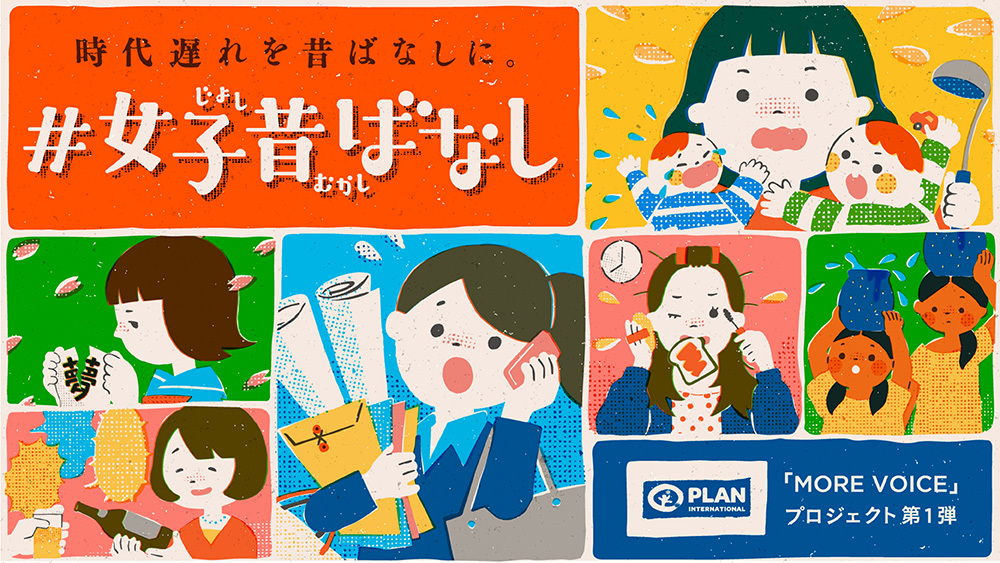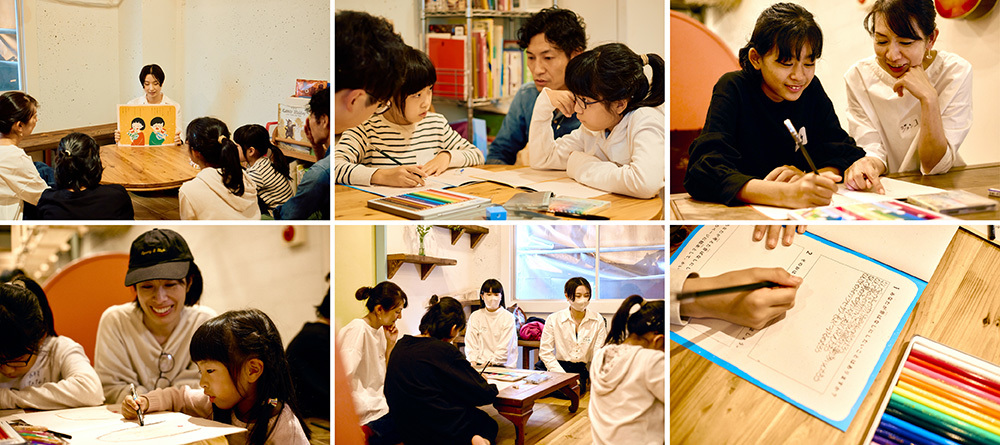How can Dentsu Inc.'s creative team contribute to the ever-evolving field of CX (Customer Experience)? "Monthly CX" is a series where members of Dentsu Inc.'s CX specialist unit, the "CXCC" (Customer Experience Creative Center), share insights ( For more on Monthly CX, click here ).
This month's feature, "Turning Outdated Stories into Folktales: #GirlsFolktales," is a project that transformed still-relevant "outdated stories" into folktale-style narratives, creating opportunities for group discussion.
We spoke with Art Director Satomi Okubo, who handled the overall design and illustration production, about the project's origins and future prospects.

[Satomi Okubo Profile]
Dentsu Inc.
Customer Experience Creative Center
Art Director
Born in Ibaraki Prefecture. Graduated from Tokyo University of the Arts, Department of Design. Focuses on branding, handling comprehensive art direction encompassing everything from planning to communication design and UI/UX. Major awards include Cannes Lions Gold, CLIO Awards Grand Prix, MAD STARS Grand Prix, NY ADC Award, THE ONE SHOW, and Good Design Award. Enjoys cats and alcohol.
【Creative Team for "#Girls' Old Tales" and Others】
Yoshifumi Sato (Creative Planning Division 3)・Chiemi Mako (Creative Planning Division 3)・Tamami Oobuchi (Customer Experience Creative Center)
The "Folktale" Format for Gently Conveying Sensitive Topics
Monthly CX: First, please tell us about the overview of "#Girls' Old Tales."

Click the image to view the site.
Okubo: It's an X-based project that transforms outdated stories about women into folktale-style narratives to spark group discussions. Starting in February 2022, we solicited posts using the hashtag "#GirlsFolktales" on X. From the collected voices, we selected seven particularly memorable episodes, illustrated them, and compiled them into a picture book. (Digital version here )
Ōkubo: Folktales are stories passed down across generations, a format that conveys various narratives clearly and gently. We consciously chose the folktale format to make sensitive topics like gender issues easier to approach.
Monthly CX: Could you tell us the background behind this project?
Okubo: Japan ranks lowest among major developed nations in the Gender Gap Index, with significant disparities between men and women, particularly in politics and economics. In the World Economic Forum's Global Gender Gap Report 2024, Japan ranked 118th out of 146 countries (※1). Furthermore, a UK survey revealed that approximately 70% of Japanese women feel unable to speak up against sexist remarks (※2).
To change this situation, we are launching the "#Girls' Tales" project in collaboration with Plan International (hereafter referred to as Plan International), an international NGO working in over 80 countries to create a world where everyone is equal.
Monthly CX: What kind of posts gathered on X?
Okubo: I recall many posts related to working women. Additionally, we gathered about 3,000 posts that made you nod in agreement, such as: "Once upon a time... there was a term 'ikumen' (hands-on dad), but mothers after childbirth are never called 'iku-woman' (hands-on mom)." Or "Once upon a time... there was an old man who said 'tea tastes better when made by women.'"
Stories like "making tea at the office" and "being made to pour drinks at drinking parties" resonated particularly strongly, making me realize many people share similar experiences.
Monthly CX: You could have just done it on X, so why make it into a picture book?
Okubo: Because I didn't want to just be satisfied with people raising their voices through the X campaign. I wanted to ensure we properly addressed it as a social issue. By digitally collecting the voices of those troubled by gender discrimination and conveying them to the children who will lead the next generation, I wanted to give back to the future.
We distributed the picture book to schools and libraries and held workshops using it for elementary school students. These steady efforts bore fruit, and it has been decided that the book will be included in the 2025 moral education textbooks for third-year junior high students.
Designing Experiences that Bridge "Digital" to "Real"
Monthly CX: You mentioned holding workshops for elementary school students. Why did you target this age group?
Okubo: This was based on research from Kyoto University indicating that the stereotype "men = smart" begins to appear around age 7 (※3).
Furthermore, it may become harder to correct these stereotypes as children get older. So, we thought it would be good to create an opportunity for elementary school children, who are likely less influenced by societal conditioning, to start thinking about gender issues.

Parent-Child Storytime & Original Picture Book Workshop at Children's Cafeterias

Storytime Session at Elementary School
Monthly CX: What did you do in the workshop?
Okubo: At the workshop held at a candy shop that also served as a children's cafeteria, I thought some kids might not have heard the word "gender." So, I explained gender issues through quizzes like "Who can become a firefighter?", "How many female politicians are there in Japan?", and "What's the difference in time spent on housework between men and women?" After that, I read picture books aloud. Finally, I had the children create their own original picture books, turning things they noticed in daily life into folktale-style stories.
Okubo: One girl wrote, "Girls wear pink shoes, but boys wear black shoes. Why can't they wear either?" based on her own experience.
Another girl wrote, "There are women-only cars to prevent groping, but since men can also be groped, it's strange there aren't men-only cars." It was refreshing to see her incorporate a male perspective.
Monthly CX: What kind of reactions did you get from the participating children?
Okubo: They shared thoughts like, "I realized I need to be careful not to discriminate based on gender," and "Even if someone says 'because you're a girl,' I want to be able to confidently say what I like from now on." One child remarked, "I realized gender matters to me as a boy too," which made me realize some children think gender is only a women's issue.
Parents also participated in the workshop, and we received a lot of positive feedback like, "I didn't know how to talk to my child about this, so this opportunity was really appreciated."
We also received suggestions like, "We'd like a version for boys too, not just girls," and "Please create versions for people with disabilities and the elderly." We hope to eventually develop sessions covering those themes as well.
It was precisely because we were prepared that we could push through
Monthly CX: Social issues like gender problems require careful verification and consideration to avoid miscommunication, including the risk of backlash. Were there any particular precautions you took while advancing the project?
Okubo: We took careful measures as a team to prevent miscommunication. Perceptions vary, and every project carries some risk of backlash, big or small. Our legal team also emphasized that "there's no such thing as a 'perfect' backlash prevention strategy." Therefore, we maintained close coordination with Plan International members to ensure we could respond immediately if anything happened.
Monthly CX: Specifically, what did you do?
Okubo: After posting on X, we held team meetings. We reviewed the next post content while monitoring user reactions, adjusted posting intervals, and made flexible changes as needed. By responding carefully like this, we avoided major backlash and were able to see the project through to the end.
I believe this project was only possible because Plan International members approached it with such commitment and dedication.
Monthly CX: Hearing your story, it's clear you built a strong relationship with the Plan International team.
Okubo: Yes, we did. I believe we established a flat relationship where we could openly share opinions as team members working together to solve the same challenge. We combined each other's strengths and weaknesses, cooperating to move forward together.
Artwork meticulously crafted down to the smallest details to evoke the atmosphere of an old tale
Monthly CX: I understand you were also responsible for creating the illustrations, Mr. Okubo.
Okubo: Yes. Before creating the illustrations, I studied old children's books and made various efforts to intuitively evoke a sense of "the old days."
Monthly CX: Indeed, just looking at the illustrations evokes a sense of nostalgia. What specific techniques did you employ?
Okubo: To recreate the uneven, slightly faded colors of old printing—unlike modern prints—I added textures with varying dot sizes and intentionally designed elements to look slightly misaligned, giving it that analog feel.
Monthly CX: So you really focused on the details.
Okubo: Yes. Beyond the analog feel, I also paid careful attention to color usage. Given the sensitive theme, I made sure to use bright, charming colors to avoid giving viewers a negative impression. Additionally, anticipating the illustrations appearing on X's timeline, I created them while checking visibility to ensure information was clearly conveyed even on small screens.
Solving social issues through creativity. Aiming for experience and product design that connects to the future
Monthly CX: How did you feel when you learned it would be featured in a moral education textbook?
Okubo: I was completely surprised and delighted because I hadn't imagined it would happen. While I usually work on ads designed to convey information to many people quickly and within short timeframes, creating a tool that provides a long-term opportunity for someone to learn and reflect offered a different kind of appeal and sense of fulfillment compared to advertising. Above all, it gave me hope that creativity can be used to solve problems.
Monthly CX: What do you think led to the decision to include your work in the textbook?
Okubo: I believe it was because our team stayed true to our vision and kept the project on track until the very end. From the planning stage, our goal was to "create a mechanism that changes the future," and we shared this vision with the members of Plan International.
Transforming digital voices into real-world experiences was the project's core focus, and securing textbook inclusion feels like we've moved closer to that goal.
Monthly CX: Finally, could you tell us what you want to pursue next with CX Creative?
Okubo: I want to design experiences and products that connect to the future, like #GirlsFolktales. When people have positive experiences, they start to see social issues they once thought were unrelated as something personal. Building on that can lead to changing society.
While short-term projects are certainly interesting, I want to actively engage in CX creative work that builds a better future for someone, with a long-term perspective.
(Editor's Note)
This time, we heard about the "#Girls' Folktales" project, which transforms digital voices into real-world experiences. By creating a space where women feel comfortable sharing their voices digitally, then compiling and distributing these voices as picture books, the project brought the voices of women who often find it difficult to speak up into real-world spaces, sparking reflection. We look forward to seeing the reactions when the books start appearing in textbooks and what kind of picture books might emerge if projects on other themes progress. As members of this society, we eagerly anticipate future developments.
If you have requests for future topics or themes you'd like us to cover, please send a message to the Monthly CX Editorial Department via the contact page below. Thank you for your continued readership.

Monthly CX Editorial Department
Dentsu Inc. CXCC: Kibata, Koike, Otani, Okumura, Kosugi, Yi, Saito, Oda, Takakusagi, Kanasaka

















